
Balt Camp July 2024
Published:
A bit of winter camping at Balt Camp in the Wombat State Forest. There are plenty of opportunities for bushwalking, birdwatching, and exploring the ruins of the former forestry camp.
About Balt Camp
The Balt Camp was established in 1946 to provide employment for displaced persons from Northern Europe. The camp’s remains, including two chimneys and the foundations of multiple buildings such as the cookhouse, manager’s hut, and toilet block, offer a fascinating glimpse into the past. The site also includes the ruins of the Able Mine, located across Camp Road.
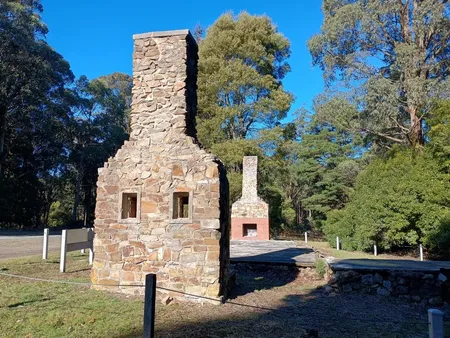
Free camping is available at the site, with a clearing behind the ruins where you can pitch a tent. Campers must be self-sufficient. The camp is also a feature along the Lerderderg Track. The forecast for Ballarat was -2°C. Balt camp, situated around 800 metres above sea level, was expected to be a couple of degrees cooler. To be prepared, I packed a heavy duty tent and a warm sleeping bag.
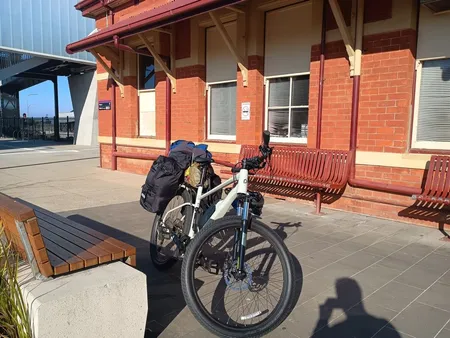
The train arrived at Ballan, and the journey continued through the town. Early on a Saturday afternoon, there was quite a bit of activity at the cafes on the main street. The route led through the town, across the freeway, and past several larger lifestyle blocks. As the houses thinned out, the path transitioned to a relatively quiet country road surrounded by farmland.
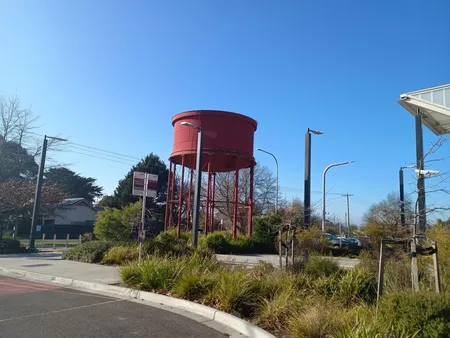
The road narrowed slightly upon approaching Blakeville, though it remained sealed. Blakeville itself consists of a few houses and a public hall. Beyond Blakeville, the road turned to gravel and began to get steeper, though it remained in reasonably good condition. Farm land gave way to forest. Google suggested taking Gentle Annie Track as a shortcut. It was extremely muddy and closed. Maybe in the summertime.
It started to get steeper turning on to Camp Road. I finally engaged the high support mode. The road got steeper and steeper as I dropped to lower gears. It wasn't far, only about 5km to go but was glad I had the e-bike.

The campsite had a couple of other campers so I decided to try my luck at the nearby Cabb camp. The track was muddy with some recent tyre tracks. I saw another camper at the campsite so I decided to move back up the track. I found a relatively flat spot. Checked the trees above for any branches that might come down and decided to pitch my tent.
The tent is an old Macpac Celeste that I've had for years. It's heavy compared to the newer tents but it's a good tent. It's roomy and taken some pretty bad weather.
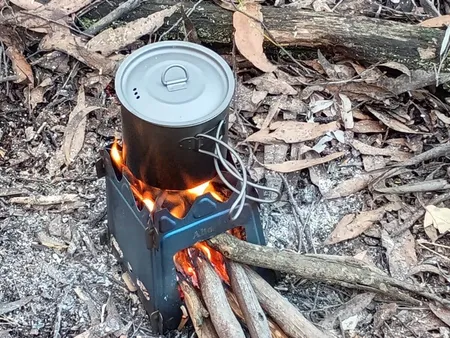
Next up was gathering sticks for the twig stove. Gathered up enough to get things going to cook dinner and to operate as a mini campfire for the next couple of hours. There's been quite a bit of rain over the last couple of weeks so the wood was a bit damp. Getting it started took a bit of care that wasn't too difficult. The stove did produce a bit of smoke big got better once things heated up and the wood dried.
The dulcet tones of Billy Joel wafted through the forest which disturbed the peace somewhat but I couldn't work out exactly where it was coming from. The sun set and a rather cold fog descended. I could feel the chill in the air but the stove did a good job of keeping things warm. Put some water on to boil 4 dinner. On the menu tonight was freeze dried beef teriyaki.
Through the darkness came the sounds of a chainsaw to add to the ambiance. Operating a chainsaw in darkness. What could possibly go wrong? Anyway, there were no screams so I assumed the operator had kept all their limbs.
A breeze started up which moved the fog on allowing the sky to clear and to get a view of some stars through the trees. It was nice watching stars and listening to the wind.
Time for bed so I crawled into the sleeping bag and slept a restful night's sleep. The frost never came due to the wind. I don't think the temperature dropped anywhere below the promised -2 degrees. At one stage I opened the tent up a little bit because it really didn't feel that cold.
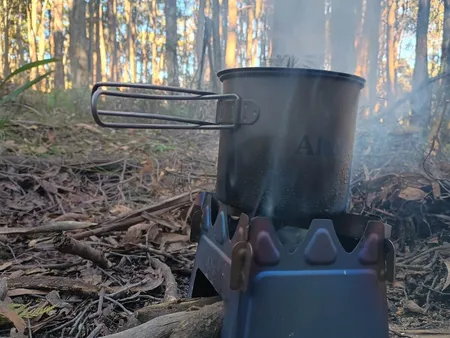
The next morning was clear with some nice sunshine. The stove was lit for morning coffee and breakfast. The titanium mug was used to boil water, and it was interesting to note that the handle remained relatively cool, making it easy to hold. Titanium, being an excellent conductor of heat, allowed for handling the small pot without worrying about burns.
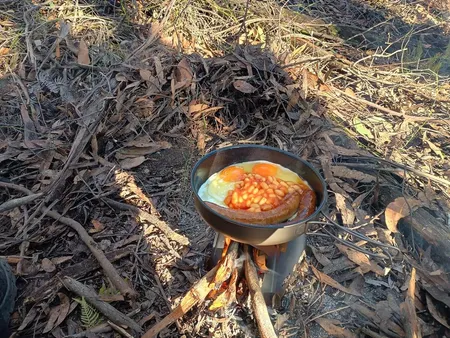
A ceramic-coated titanium frying pan was also tested. It was supposed to be non-stick, and this was put to the test with sausages, eggs, and baked beans. Due to titanium’s excellent heat conduction, the heat source had to be watched closely, and the pan moved around to ensure even cooking. Overall, it did a good job.
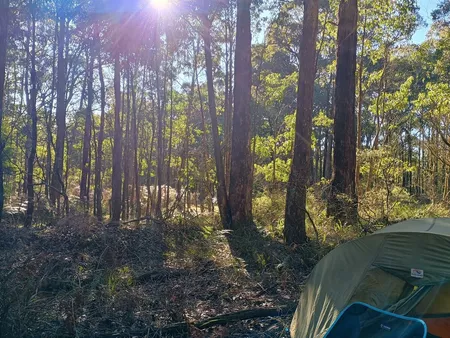
It was a lazy morning, spent sitting in a chair, drinking coffee, eating breakfast, and taking in the surroundings. Once breakfast had settled, a walk was taken to explore the Balt Camp ruins, followed by packing up the campsite. The journey back was mainly downhill, letting gravity do its work. The brakes were used frequently to control speed, ensuring it was safe for the conditions and skill level. It was a nice, easy descent back into Ballan, where the train was awaited to return home.
Getting There
- Car: The Balt Camp is located in the Wombat State Forest,. To get there, take the Western Freeway to the Ballan-Daylesford Road exit, then turn right onto Spargo-Blakeville Road. Follow this road until you reach Camp Road, then turn left and continue until you reach the campsite. You can reach the ruins by car. Access to the campsite itself requires a 4WD.
- Public Transport: The closest train station is Ballan, on the Ballarat line. Then, it is about 20km to walk or cycle to the campsite via Blakeville Road.
Balt Camp
- Facilities: None. You need to be self sufficient.
- Cost: Free
- Water: None. You need to bring your own.
- Access: Gravel road. Could be 2WD accessible in good weather but 4WD recommended.